华中农业微生物学第一章英文版
- 格式:ppt
- 大小:5.26 MB
- 文档页数:41
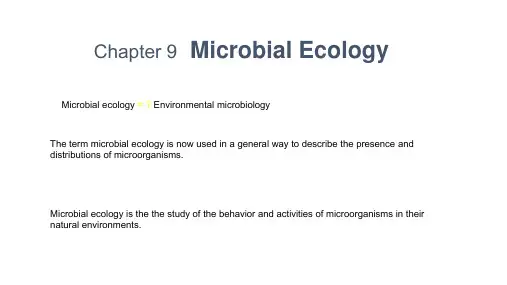

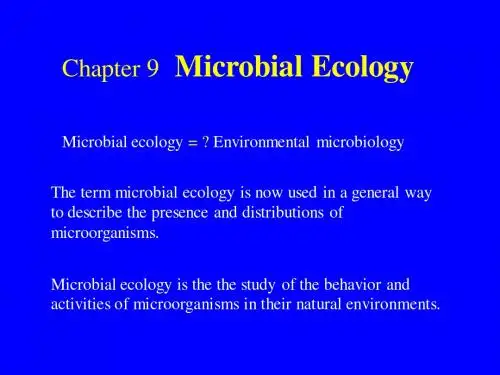


华中农业大学考研《微生物英语》题库关键信息项:1、题库的版权归属2、题库的使用范围和限制3、题库的更新与维护4、保密条款5、违约责任6、争议解决方式11 协议背景本协议旨在规范华中农业大学考研《微生物英语》题库(以下简称“题库”)的使用、管理和相关权益。
111 定义在本协议中,“题库”指为华中农业大学考研《微生物英语》课程所准备的一系列试题及相关学习资料。
12 协议目的本协议的目的是确保题库的合法、合理使用,保护相关权益,促进教学与学习的顺利进行。
21 题库的版权归属题库的版权归华中农业大学所有。
未经授权,任何个人或组织不得对题库进行复制、传播、改编或用于商业目的。
211 版权保护措施使用者应遵守版权法律法规,不得采取任何侵犯版权的行为。
如有发现侵权行为,华中农业大学有权采取法律手段维护自身权益。
31 题库的使用范围和限制311 仅限考研学生使用题库仅供报考华中农业大学相关专业研究生的学生使用,用于备考复习。
312 校内使用原则学生应在学校规定的学习场所内使用题库,不得将其带出校外或用于非考研相关的活动。
313 禁止传播学生不得将题库的内容传播给非考研人员,包括但不限于在互联网上公开分享、借给他人等。
41 题库的更新与维护411 学校责任华中农业大学将定期对题库进行更新和维护,以确保其内容的准确性和时效性。
412 通知义务学校在对题库进行重大更新时,将提前通知使用者,并说明更新的内容和时间。
51 保密条款511 学生保密义务使用者应对题库的内容保密,不得向外界透露题库中的试题及相关信息。
512 保密期限保密义务在考研结束后仍需持续一定期限,具体期限由学校规定。
61 违约责任611 侵权责任若使用者违反本协议的规定,侵犯了题库的版权或违反了保密条款,应承担相应的法律责任,并赔偿学校因此所遭受的损失。
612 违规使用责任对于违规使用题库的学生,学校有权取消其使用资格,并根据情节轻重给予相应的处分。
71 争议解决方式711 协商解决如在本协议的履行过程中发生争议,双方应首先通过友好协商解决。
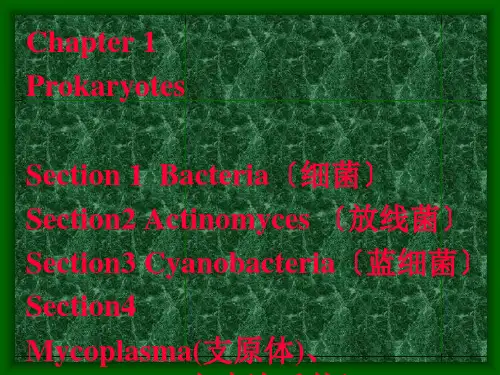

【最新】华中农业大学考研《微生物英语》题库整理Test 1: Development of Microbiology1 Multiple Choice (choose one answer)1.The fundamental unit of all living organisms is theMembrane cell nucleus cell wall/doc/c03756477.html,anisms that do not contain a true nucleus are referred to asfungi eukaryotic prokaryotic nankaryotic3.The three kingdom classification system of organisms was proposed byPasteur Bacon Winogradsky Woese4.Fungi differ from bacteria in a number of characteristics. The cell walls in fungi arecomposedof , while the cell walls of bacteria are composed of peptidoglycan Chitin phospholipids protein glucosamine5.The first microscopes were developed byEhrlich Metchnikoff Leewenhoek Lister6.Control of microbial infections can be accomplished by chemical or immune mechanisms.The first report on the production of an antibiotic is credited to:Lister Fleming Ehrlich Koch7The term "antibiotic" meansa substance produced by the laboratory that kills or inhibits other microorganismsa substance produced by microorganisms that kills or inhibits moldsa substance produced by microorganism that kills or inhibits other microorganismsa substance produced by microorganisms that kills or inhibits cancer cells8 The first documented use of a vaccine for smallpox was reported by the English physicianLister .Florey Fleming Jenner9 Active immunity can be distinguished from passive immunity in that the former requires:development of antibodies in one's own body by stimulation with external antibodiesdevelopment of antibodies in one's own body by stimulation with external antigensFlemingdevelopment of antibodies in a foreign host and transfer to one' s own bodydevelopment of antigens in one's own body by stimulation with external antibodies10The process of nitrification by bacteria described by Winogradsky converts ammonia to nitrate ions nitrate ions to ammoniaN2 to ammonia ammonia to urea11The transfer of DNA from one organism to another through the use of a viral vector is referred to asElectroporation conjugation transformation transduction12The genetic material of a bacteria is located in the molecule:RNA DNA protein lipid2 Fill in the Blank/doc/c03756477.html,anisms that contain a true nucleus are called_______2.Bacteria do not have a true nucleus and are considered _______3.. Bacteria can be divided into two groups, the _______and the ______4._______ are organisms that can grow without using molecular oxygen.5. Microorganisms that can synthesize complex organic compounds from CO2:are called_______.6. ______ are microorganisms that obtain their energy to synthesize organic compounds fromlight.7. ______ require organic compounds for growth.8. Organisms that survive only at very high temperatures are referred to as______.9. ______ are organisms that produce methane from CO2.10. ______organisms grow under conditions of high salinity11. Eubacteria can exhibit a number of morphological shapes. Identify four: a.______b.______c.______d.______12. Fungi, algae and protozoa can be differentiated from bacteria by the followingcharacteristic:_______ .13. Fungi have cell wall consisting of _______.14. Viruses consist of ______surrounded by a protein coat.15. The scientific method utilizes deductive reasoning and observations or experiments toprove or disprove a _____.16. The theory _______of held that living organisms could arise from nonliving matter.17. The process used to reduce the number of viable organisms by moderate heating iscalled:_______ .18. The process of tyndallization uses repeated heating to eliminate or_______microorganisms from solutions.19.An _______is a substance produced by microorganisms that inhibits or kills othermicroorganisms.20. The process of stimulating the immune defenses of the body is referred to as_______.21. White blood cells that engulf foreign particles are referred to as______.22. A substance in serum that can neutralize foreign material is referred to as ______or______.23. Cells infected with a virus produce a substance called ______ that inhibits viralreplication.24. Avery, Colin and MacLeod first demonstrated that transformation of nonpathogenic topathogenic strains of bacteria could be carried out by the transfer of ______.25. Exchange of genetic information by direct contact is referred to as______.26. ______ is the process in which DNA is transferred from one bacteria to another.Test 2: Methods for Studying Microorganisms1 Multiple Choice (choose one answer)1.Light microscopy is dependent on the interaction of lightwith on object. The ability oflight to pass through an object is referred to as:transported light transmitted light reflected light refracted light2. The resolving power (R) of a microscope is dependent on the wavelength of light (;~) and the numerical aperture (NA) of the lens. The formula for R is:R = 0.5~. xNA R = 0.5;~/NA R = NA/0.5Jr R = Square root of 0.5)./NA3. The gram stain uses ~ as a mordant to fix the primary stainIodine alcohol acetone safranin4.The acid-fast stain is useful in the identification of which of the following organismsStaphylococcus aureus Mycoplasma mycoides Mycobacteria tuberculosis Moraxella osloensis5.Botulism is a serious disease that can develop from the improper cooking of foodcontaining bacterial spores. Which of the following genera are capable of producing spores?Salmonella Listeria Escherichia Clostridia6.Which of the following types of microscopes utilizes electron beams to visualize objects?Nomarski TEM PCM Confocal7. A mixture of organisms was isolated from a patient suspected of having "Strep Throat."Which type of media would you use to isolate the suspected pathogen?Defined enriched selective differential8.Sterilization of material with an autoclave utilizes steam to kill microorganisms. Thecorrect procedure for sterilization with an autoclave is:15 min at 121℃at 15 lb/in2 15 min at 256℃ at 15 lb/in2 15 min at 121℃at 1 lb/in215 m in at 121℃at 1 lb/in29. An antibiotic was added to a culture of bacteria to determine its effect. What method of enumeration would you use to determine the efficacy of the antibiotic?direct count viable count turbidimetric count absorbance9.Identification of microorganisms can be accomplished by a number of techniques.Which of the following requires the growth of the organism?enzyme linked assay gene probe metabolic fluorescent2 Fill in the Blank1. A media where all the ingredients are known is called a ______media.2.______technique is used to maintain a pure culture and avoid contamination.3.Sterilization instrument that utilizes steam under pressure: _______.4.A______ plate utilizes a loop or needle to distribute and isolate colonies on a cultureplate.5.______ identification utilizes antibodies for naming of bacterial species.6.Bacteria can be preserved for long periods of time by freeze-drying or______.7.The mrbidimetric method of counting bacteria utilizes a ______ to measure theamountof light passing through a solution.8.The viable plate count counts live bacterial colonies in therange or______ to______9. A counting chamber and a microscope are used in the______ count of bacteria.Test3: Organization and Structure of Microorganisms1Multiple Choice (choose one answer)1.Eukaryotic membranes can be differentiated from prokaryotic membranes becauseeukaryotic membranes contain____as part of the lipid component of the membrane.Phosphates fatty acids proteins sterols2.The arrangement of proteins and lipids in the membrane is referred to as the:bilayer model fluid mosaic model trilayer model permeable model3.The movement of water molecules across the membrane in response to aconcentration gradient is referred to asDiffusion osmosis translocation transport4.The membrane of a cell is able to differentiate molecules that enter or exit the celland act as a ____ barrier.Semipermanent semitransparent semipermeable semidiffuse5.Movement of molecules at an enhanced rate across the membrane is called facilitated diffusion passive diffusion osmosis permeation6.Which of the following mechanisms transports molecules without chemicalalteration?active transport group translocation facilitated diffusionbinding protein transport 7.Which of the following transport mechanism occurs only in Gram-negativebacteria?active transport group translocation facilitated diffusion binding protein transport8.Which of the following transport mechanisms occurs only in prokaryotes?active transport group translocation facilitated diffusion binding protein transport9.Lysozyme and penicillin have activity against the cell wall. Lysozyme breaks thiscomponent;penicillin prevents its formationLipopolysaccharide phospholipid peptidoglycan teichoic acid10.Partial destruction of the cell wall with lysozyme leaves a cell called a:Protoplast spheroplast periplast capsule2 Fill in the Blank1.Most cells use energy in the form of______ to run the cell.2.Phospholipids of eubacterial cells are composed of a ______group and a _____on aglycerol backbone.3.Membrane proteins found on the surface are called ______ proteins.4.The energy source for active transport in eukaryotes is derived from ATP.The energy foractive transport in prokaryotes is derived from ______.5.The region between the outermembrane in Gram-negative bacteria and the cell wall iscalled the _______.6.Extrachromosomal DNA elements found in bacteria are called________.7.Ribosomes are structures composed of _______ and ______.8.The fluid inside a cell is referred to as the ________.9.The hereditary organelle of eukaryotic cells is called the ______.10.The process by which a cell engulfs and internalizes particles such as bacteria or othercells is called ______.Test 4 :Eukaryotes1 Multiple Choice (choose one answer)l. Fungi are considered heterotrophic because they obtain nutrition throughphagocytosis endocytosis adsorption photosynthesis2.The separation between filamentous fungal cells are referred to asFill in the Blank1.Unicellular fungi are called ______.2.Filamentous fungi form branching structures called ______3.The most common form of reproduction in yeasts occurs by ______.4.Silica is found in the cell wall of ______.5.The external structures of mushrooms are referred to as _______.6.The growth of fungi can be expressed by _____.7.Red tide is caused by a toxin released by the organism, Gonyaulax, which belongs to the______ group of fungi.8.Agar is made from this group of algae: ______.9.Trypanosoma gambiense causes the disease ______.10. A flagellate protozoa that can be found in mountain streams and causes d iarrhea is______.Test5: Bacterial Growth and Reproduction1 Multiple Choice (choose one answer)1. In bacterial cultures, growth can be demonstrated by an increase in:Mass cell size cell number cell length2DNA replication in bacteria is controlled by:cell size cell division cell separation cell initiation3.During which phase of bacterial growth is there an increase in cell size but not in cellnumber?Lag log stationary exponential4.The generation time for bacteria is determined by:measuring the time it takes to double the number of bacteria from the time the culture was initiated until the beginning of stationary phasemeasuring the time it takes to double the number of bacteria from lag phase to death phase measuring the time it takes to double the number of bacteria from log phase to the end of stationary phasemeasuring the time it takes to double the number of bacteria from log phase to the beginning of stationary phase5.Most pathogenic bacteria are considered:Psychrophiles mesophiles thermophiles .merophiles6.Bacteria that grow at low nutrient concentrations are referred to as:Autotrophs phototrophs copiotrophs oligotrophs7.In times of nutrient deficiencies, the bacteria Clostridiumproduce____until conditionsare permissive for vegetative growth.Prosthecae spores stalks fruiting bodies8.The temperature of the incubator was raised from 15~(2 to 35~(2. The cultures in theincubator demonstrated a____fold increase in enzymatic activityTwo for eight twenty/doc/c03756477.html,anisms that grow at or near their optimal growth temperature are called stenothermal bacteria euthermal bacteriacauldoactive bacteria mesophilic bacteria10.All of the following are toxic oxygen products except:02 OH- H20 H20211. Catalase, which is produced by Staphylococci, catalyzes which of the following reactions?202+ 2H+ →2H202 + 02202+ 2H+ →2H202 + 02H202 + NADH + H+→2H20 + NADH202 + e- + H+→H2O + OH-12 A saturated solution of NaC1 has a water activity index of:1.0 0.90 0.80 0.7013. Organisms that can grow at a water index at or below that of NaCI are called Xerotolerant .salt tolerant mesotolerant salotolerant14. All of the following organisms will survive an environment of 0.9 Aw except Lactobacillus Staphylococcus .Saccharomyces SpiriUum15alophiles are classified as organisms that require ____for growth.Sugar salt .water air16.Osmophiles require a ____Aw for growth.Low high17.The pressure exerted on a cell due to high solute concentrations is referred to as: osmotic pressure hydrostatic pressure barometric pressure surface tension18. A diver encountered a new bacterial isolate while she was diving at 1000 m. Theorganism will be classified as:Marine barotolerant barophilic normal19.Fungi can be differentiated from most bacteria by culturing at:Marine low pH neutral pH20.All phototacfic bacteria respond to light by:moving away from the source of lightmoving toward the source of lightincreasing the movement of their flagellacreating gas vesicles to rise to the surface2 Fill in the Blank/doc/c03756477.html,anisms that grow best above 40oC are called______./doc/c03756477.html,anisms that grow best below 20oC are called______./doc/c03756477.html,anisms that grow best between 20 and 40oC are called ______.4.Myxobacteria form unique structures called ______ to cope with nutrient deficiencies.5.Bacteria that grow only at reduced oxygen concentrations are called _______.6.Bacteria that require oxygen for growth are called_____.7.Bacteria that grow at high nutrient concentrations are called ______.8.Caulobacter is an example of a ______ bacteria.9.At temperatures above the optimum, E. coli and other bacteria induce a change in geneexpression called______10. A change in hydrostatic pressure of 10 atm is experience with an increase in depth of______ mTest 6: Control of Microbial Growth1 Multiple Choice (choose one answer)1. Chemicals used on the body to control microorganisms are called:Antiseptics disinfectants antibiotics chemotherapeutic2.The most effective way of sterilizing a solution is by:Incineration pasteurization filtration moist heat3.An autoclave is an apparatus that is used to sterilize various materials. Theappropriate conditions for sterilizing contaminated material is given by which of thefollowing:15 min at 121℃at lpsi5 min at 121℃at 15 psi15 min at 121℃at 15 psi5 min at 131℃at 15 psi4. All of the following are an effect of ionizing radiation except:breaks hydrogen bondsthymine dimer formationgenerates oxygen radicalsring structure destruction5 hyperbaric chamber would be useful for treating infections caused by which of the following genera:Treponema Chlamydia Campylobacter Clostridia6.Agents that are used to inhibit bacterial growth are consideredBacteriocidal bacteriostatic antiseptics disinfectants7.The term used to describe substances produced by microorganisms that kill or inhibitother microorganisms are calledAntimicrobics antibiotics chemotherapeutic agents antiseptics8.Antibiotics must exhibit which of the following to be effective:narrow spectrum broad spectrum selective toxicitybacteriocidal9.Which of the following tests utilizes an antibiotic impregnated disk to test for theefficacy of the antibiotic?MIC MBC Mueller-Hinton Kirby-Bauer10.The MIC assay can determine if an antibiotic agent is:Bacteriocidal bacteriostatic aandb none of the above11.Penicillins are effective against:cells in log phase cellsin stationary phasecells in eclipse phaseall bacterial cells12.Penicillinases inhibit the activity of penicillins by which of the following mechanisms: break N. acetylglucosamine:N-acetylmuramic acid bondsbreak the peptidiglycan break the beta lactam ring break cycloserine。
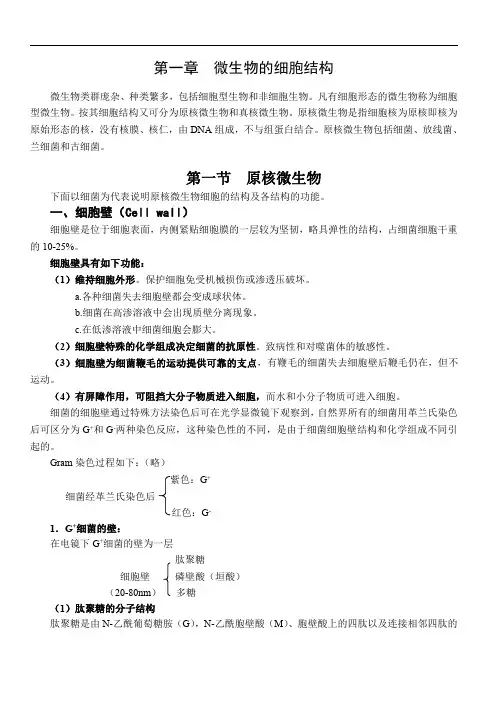
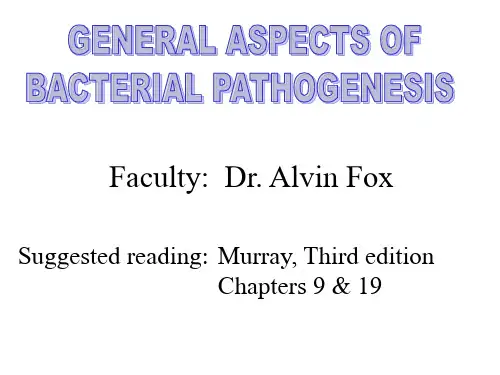
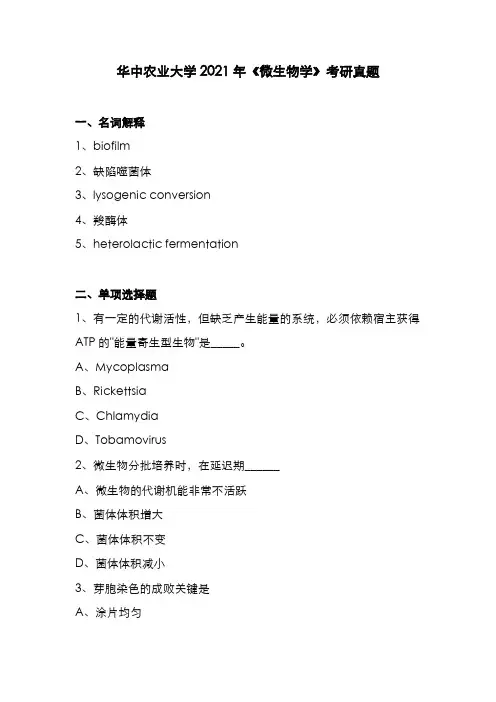
华中农业大学2021年《微生物学》考研真题一、名词解释1、biofilm2、缺陷噬菌体3、lysogenic conversion4、羧酶体5、heterolactic fermentation二、单项选择题1、有一定的代谢活性,但缺乏产生能量的系统,必须依赖宿主获得ATP的"能量寄生型生物"是_____。
A、MycoplasmaB、RickettsiaC、ChlamydiaD、Tobamovirus2、微生物分批培养时,在延迟期______A、微生物的代谢机能非常不活跃B、菌体体积增大C、菌体体积不变D、菌体体积减小3、芽胞染色的成败关键是A、涂片均匀B、孔雀绿加热时间适当C、玻片干净无油污D、番红复染4、微生物细胞中的aw值通常是A、细菌>酵母>霉菌>嗜盐菌B、酵母>霉菌>细菌>嗜盐菌C、霉菌>酵母>细菌>嗜盐菌D、嗜盐菌>酵母>细菌>霉菌5、下面不属于质粒特征的是A、能自我复制B、存在细胞质中C、属于细菌的基本构造D、有的真核生物中也存在6、我国学者汤飞凡教授分离和确证了____A、鼠疫杆菌B、沙眼衣原体C、结核杆菌D、天花病毒7、土壤具有的特殊泥腥味主要来源于_____。
A、SaccharomycesB、ActinomycesC、PseudomonasD、Bacillus8、Rhizopusstolonifer的无性繁殖是产生__A、分生孢子B、孢囊孢子C、厚垣孢子D、节孢子9、在以下能进行光合作用的微生物中,不含叶绿素和菌绿素的是__°A、红螺菌B、蓝细菌C、衣藻D、嗜盐菌10、蓝细菌保护其固氮酶不受氧毒害的机制之一是____。
A、形成泡囊B、构象保护C、血红蛋白保护D、形成异形胞11、___历反应中产生的4-磷酸赤藓糖可用于合成芳香族氨基酸。
A、EMPB、HMPC、TCAD、ED12、担子菌长期维持双核细胞的大量繁殖须借助______。
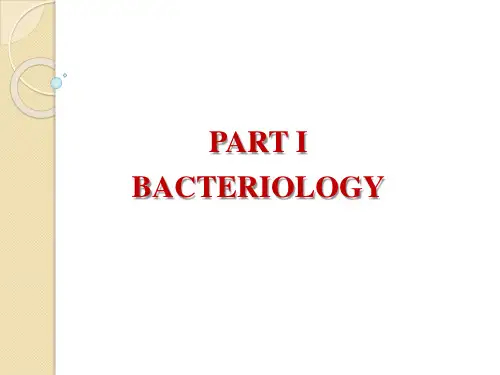
/kech/wswx/cn/test/shiti.htm华中农业大学微生物试题集(仅参考)*不做重点*Section 1 Microorganisms and Microbiology1Archaea :a group of phylogenetically related prokaryotes distinct from Bacteria2Bacteria :a group of phylogenetically related prokaryotes distinct from Archaea 3 Chromosome:a genetic element carrying genes essential to cell function4DNA :deoxyribonucleic acid, the hereditary material of cells and some viruses 5 Enrichment culture:a method for isolating microorganisms from nature using specific culture media and incubation conditions6 Enzymes :protein catalysts that function to speed up chemical reactions7 Eukaryote:a cell possessing a membrane-enclosed nucleus and usually other organelles8Genetics :heredity and variation of living organisms9Microorganism :a microscopic organism consisting of a single cell or cell cluster, including the viruses10 Plasmid:a small genetic element that exists separately from the chromosome 11Pure culture :a culture containing a single kind of microorganism12Spontaneous generation :the hypothesis that living organisms can originate from nonliving matter13Aseptic :technique methods for maintaining sterile culture media and other sterile objects free from microbial contamination during manipulations14Cell :the fundamental unit of living matter15Cytoplasm :the fluid portion of a cell, bounded by the cell membrane but excluding the nucleus (if present)16Ecology :the study of organisms in their natural environments17 Entropy:a measure of the degree of disorder in a system; entropy always increases in a closed system18Eukarya :all eukaryotic organisms19Evolution :change in a line of descent over time leading to the production of new species or varieties within a species20Metabolism :all biochemical reactions in a cell21 Pathogen:a disease-causing microorganism22 Prokaryote:a cell lacking a nucleus and other organelles23 RNA:ribonucleic acid, involved in protein synthesis as messenger RNA, transfer RNA, and ribosomal RNA24 Sterile:absence of all living organisms and virusesSection 2 Cell Biology1Antigen-Binding Cassette transporter :a membrane transport system consisting of three proteins, one hydrolyzes ATP as an energy source to drive the transport event, one binds the substrate on the outside of the cell, and one functions as the transport channel through the membrane2Chloroplast :the chlorophyll-containing photosynthetic organelle of eukaryotic photosynthetic organisms3 Cytoplasmic:membrane the permeability barrier of the cell, separating the cytoplasm from the environment4 Eukaryote :a cell containing a membrane-enclosed nucleus and usually other organelles5Gas vesicles :gas-filled cytoplasmic structures bounded by protein and coriferring buoyancy on cells6 Gram-positive:a prokaryotic cell whose cell wall consists chiefly of peptidoglycan and lacks the outer membrane of gram-negative cells7Lipopolysaccharide (LPS):lipid in combination with polysaccharide and protein forming the major portion of the cell wall in gram-negative Bacteria8 Mitochondrion (mitochondria):an organelle found in most eukaryotic cells in which respiration and energy generation occurs9Nucleus:a membraned-enclosed structure in cells of Eukarya that contains the genetic material, arranged in chromosomes10 Flagellum:Peptidoglycan :a polysaccharide composed of alternating repeats of acetylglucosamine and acetylmuramic acid with the latter in adjacent layers cross-linked by short peptides11 Peritrichous:in reference to flagellation pattern; flagella located in many places around the surface of the cell Phototaxis movement of an organism toward light12 Prokaryote:a cell that lacks a membrane-enclosed nucleus and that usually has a single circular DNA molecule as its chromosome13 Ribosome :small particles composed of RNAs and proteins that function in protein synthesis14Chemotaxis :movement of an organism toward (positive) or away from (negative) a chemical gradient15Chromosome :a DNA molecule, usually circular in prokaryotes and linear in eukaryotes, carrying genes essential to cellular function16Endospore:a highly heat-resistant, thick-walled, differentiated cell produced by certain gram-positive Bacteria17 Flagellum :a long, thin cellular appendage capable of rotation in prokary otic cells and responsible for swim-ming motility18 Gram-negative:a prokaryotic cell whose cell wall contains relatively little peptidoglycan but contains an outer membrane composed of lipopolysaccharide, lipoprotein, and other complex macromolecules19 Group translocation:an energy-dependent transport process in which the substance transported is chemi-cally modified during the transport process20 Magnetosomes:particles of magnetite (Fe3O4) organized into nonunit membrane-enclosed structures in the cytoplasm of magnetotactic Bacteria21 Nucleoid:an aggregated state of the circular chromosome of prokaryotic cells22 Organelle:a unit membrane-enclosed structure found in the cytoplasm of eukaryotic cells23Periplasm :a gellike region between the outer surface of the cytoplasmic membrane and the inner surface of the lipopolysaccharide layer of gram-negative Bacteria24 Poly-P-hydroxybutyrate (PHB):a common storage material of prokaryotic cells consisting of a polymer of P-hydroxybutyrate or another 3-alkanoic acid25 Protoplast :an osmotically protected cell whose cell wall has been removedSection3 Prokaryotic Microorganisms1 Acid fastness:a property of Mycobacterium species in which cells stained with the dye basic fuchsin resist decolorization with acidic alcohol2Chemolithotrophs :organisms able to oxidize inorganic compounds as energy sources3 Consortia:two or more-membered association of prokaryotes, usually living in an intimate symbiotic fashion4Enteric bacteria :a large group of gram-negative rod-shaped Bacteria characterized by a facultatively aerobic metabolism5 Heliobacteria:anoxygenic phototrophs containing bacteriochlorophyll g6Heterocyst :a differentiated cyanobacterial cell that carries out nitrogen fixation but not oxygenic photosynthesis7Homofermentative :in reference to lactic acid bacteria, producing only lactic acid as a fermentation product8 Methylotroph :an organism capable of oxidizing organic compounds that do not contain carbon-carbon bonds; if able to oxidize CH4, also a methanotroph9 Purple nonsulfur bacteria:a group of phototrophic prokaryotes containing bacteriochlorophylls a or b that grow best as photoheterotrophs and have a relatively low tolerance for H2S10 Prostheca :an extrusion of cytoplasm often forming a distinct appendage, bounded by the cell wall11 Pseudomonad:member of the genus Pseudomonas, a large group ofgram-negative, obligately respiratory (never fermentative) Bacteria12 Spirochete :a slender, tightly coiled gram-negative prokaryote characterized by possession of axial filaments used for motility13 Sulfate-reducing bacteria :a large group of anaerobic Bacteria that respire anaerobically with SO42- as electron acceptor, producing H2S14 Carboxysomes :polyhedral cellular inclusions of crystalline ribulose bisphosphate carboxylase (RubisCO), the key enzyme of the Calvin cycle15Chlorosomes :cigar-shaped structures bounded by a nonunit membrane and containing the light-harvesting bacteriochlorophyll (c, d, or e) in green bacteria and Chloroflexus16 Cyanobacteria :prokaryotic oxygenic phototrophs that contain chlorophyll a and phycobilins but not chlorophyll b17 Green bacteria:anoxygenic phototrophs containing chlorosomes and bacteriochlorophyll c, cs, d, or e as light-harvesting chlorophyll18 Hyperthermophile:an organism with a growth temperature optimum of greater than 80oC19Heterofermentative :in reference to lactic acid bacteria, capable of making more than one fermentation product20 Methanotroph :an organism capable of oxidizing methane (CH4)21 Nitrifying bacteria:chemolithotrophs capable of carrying out the transformation NH3?NO2- or NO2-?NO3-22 Prochlorophyte :a prokaryotic oxygenic phototroph that contains chlorophyllsa andb but lacks phycobilins23 Proteobacteria :a major lineage of Bacteria that contains a large number of gram-negative rods and cocci24Purple sulfur bacteria :a group of phototrophic prokaryotes containing bacteriochlorophylls a or b and characterized by the ability to oxidize H2S and store elemental sulfur inside the cells (or in the genus Ectothiorhodospira, outside the cell)25 Stickland reaction :fermentation of an amino acid pair in which one amino acid serves as an electron donor and a second serves as an electron acceptor Section4 Eukaryotic Microorganisms1Ameboid movement :a type of motility in which cytoplasmic streaming moves the organism forward2Chloroplast:the photosynthetic organelle of eukaryotic phototrophs3 Conidia:asexual spores of fungi4Flagellates :a group of protozoa characterized by motility driven by the whiplike action of one or more long,thin appendages called flagella5 Hydrogenosome:an organelle of endosymbiotic origin present in certain anaerobic eukaryotic microorganisms that functions to oxidize pyruvate to H2, CO2, and acetate, along with the production of one ATP6 Molds:filamentous fungi7Phagocytosis :a mechanism for ingesting particulate food in which a portion of the cell membrane surrounds the particle and brings it into the cell8 Slime molds:nonphototrophic eukaryotic microorganisms that lack cell walls and that aggregate to form fruiting structures (cellular slime molds) or masses of protoplasm (acellular slime molds)9 Yeasts:unicellular fungi10Chitin :a polymer of N-acetylglucosamine commonly found in the cell walls of algae and fungi11 Ciliates:a group of protozoa characterized by rapid motility driven by numerous short appendages called cilia12 Eukarya :all eukaryotic organisms13Fungi :nonphotosynthetic eukaryotic microorganisms that contain rigid cell walls14 Mitochondrion:the respiratory organelle of eukaryotic organisms15 Mushrooms :filamentous fungi that produce large, often edible structures called fruiting bodies16 Protozoa :unicellular eukaryotic microorganisms that lack cell walls17 Sporozoa :nonmotile parasitic protozoaSection 5 Viruses1Bacteriophage:a virus that infects prokaryotic cells2Lysogen:a bacterium containing a prophage3Oncogene:a gene whose expression causes formation of a tumor4Plus (positive)-strand nucleic acid :an RNA or DNA strand that has the same sense as the mRNA of a virus5Provirus (prophage):the genome of a temperate virus when it is replicating with, and usually integrated into,the host chromosome6Reverse transcription:the process of copying information found in RNA into DNA7Transformation :a process by which a normal cell becomes a cancer cell (but see alternative usage in Chapter 9)8Virulent virus:a virus that lyses or kills the host cell after infection; a nontemperate virus9Minus (negative)-strand nucleic acid:an RNA or DNA strand that has the opposite sense of (is complementary to) the mRNA of a virus10Plaque:a zone of lysis or cell inhibition caused by virus infection of a lawn of sensitive cells11Prion:an infectious agent whose extracellular form may contain no nucleic acid12 Retrovirus:a virus whose RNA genome has a DNA in-termediate as part of its replication cycle13Temperate virus :a virus whose genome is able to replicate along with that of its host and not cause cell death in a state called lysogeny14 Virion:the complete virus particle; the nucleic acid surrounded by a protein coat and in some cases other material15Virus:a genetic element containing either RNA or DNA that replicates in cells but is characterized by having an extracellular stateSection 6 Nutrition and Metabolism1Activation Energy energy the energy required to bring substrates to the reactive state2 Anabolism:the sum total of all biosynthetic reactions in the cell3 Catabolism:biochemical reactions leading to the production of usable energy (usually ATP) by the cell4 Chemoorganotroph :an organism that uses organic chemicals as energy sources (electron donors)5 Coenzyme :a small nonprotein molecule that participates in a catalytic reaction as part of an enzyme6 Culture medium :an aqueous solution of various nutrients suitable for the growth of microorganisms7 Electron acceptor:a substance that can accept electrons from some other substance, thereby becoming reduced in the process8 Enzyme:a protein that has the ability to speed up (catalyze) a specific chemical reaction9 Free energy :(G) energy available to do work10 Phototroph :an organism capable of using light as an energy source11 Reduction potential :the inherent tendency (measured in volts) of a compound to donate electrons12Siderophores :iron chelators that can bind iron present at very low concentrations13 Aerobe :a microorganism able to use O2 in respiration14 Autotroph :an organism capable of biosynthesizing all cell material from CO2 as the sole carbon source15 Chemolithotroph:an organism that uses inorganic chemicals as energy sources (electron donors)16 Citric acid cycle :a cyclical series of reactions resulting in the conversion of acetate to two CO217 Complex medium:a culture medium composed of digests of chemically undefined substances such as yeast and meat extracts18 Defined medium :a culture medium whose precise chemical composition is known19 Electron donor:a substance that can donate electrons to some electron acceptor, thereb y becoming oxidized in the process20 Fermentation:anaerobic catabolism in which an organic compound serves as both an electron donor and an electron acceptor and in which ATP is produced by sub-strate-level phosphorylation21 Oxidative phosphorylation:the production of ATP at the expense of a proton motive force formed by electron transport22Proton motive force :an energized state of the membrane resulting from the separation of charge and the elements of water (H+ versus OH?) across the membrane23Respiration :the process in which a compound is oxidized with O2 or an O2 substitute functioning as the terminal electron acceptor, usually accompanied by ATP production by oxidative phosphorylation24 Substrate-level phosphorylation :production of ATP by the direct transfer of a high energy phosphate molecule from a phosphorylated organic compound to ADPSection 7 Microbial Growth and Growth Control1 Acidophile:an organism that grows best at low pH2 Alkaliphile :an organism that grows best at high pH3Batch culture :a closed-system microbial culture of fixed volume4 Compatible solute:a molecule that is accumulated in the cytoplasm for adjustment of water activity but that does not inhibit biochemical processes5 Extremophile:an organism that grows optimally under one or more chemical or physical extremes, such as high or low temperature or pH6 Generation time:the time required for a population of microbial cells to double7 Halophile:a microorganism that requires NaCI for growth8 Lag phase:a period preceding the exponential growth phase when cells may be metabolizing but are not yet growing9 Mesophile:an organism that grows best at temperatures between 20 and 45oC10 Psychrophile:an organism with a growth temperature optimum of 15oC or lower and a maximum growth temperature below 20oC11 Stationary phase:the period immediately following exponential growth when the growth rate of the population falls to zero12Viable :capable of reproducing13 Aminoglycosides :a group of antibiotics, including streptomycin, containing amino sugars linked by glycosidic bonds14 Antibiotic resistance :the acquired ability of a microorganism to grow in the presence of an antibiotic to which the microorganism is usually sensitive15Antiseptic :antimicrobial agents that are sufficiently nontoxic to be applied on living tissues16β-Lactam antibiotics:a group of antibiotics, including penicillin, that contain the four-membered heterocyclic β-lactam ring17 Bacteriostatic:inhibits bacterial growth18 Decontamination:treatment that renders an object or inanimate surface safe to handle19 Disinfection:the process of eliminating nearly all pathogens, but not all microorganisms, from inanimate objects or surfaces20 Inhibition:the reduction of microbial growth because of a decrease in the number of organisms present or alterations in the microbial environment21 Lysis:loss of cellular integrity with release of cytoplasmic contents22 Semisynthetic penicillin :a natural penicillin that has been chemically altered23 Tetracycline:an antibiotic characterized by a four-mem-bered naphthacene ring24 Aerobe:an organism that can use O2 in respiration; some require O2 for growth25 Anaerobe :an organism that cannot use O2 in respiration and whose growth may be inhibited by O226 Chemostat:a device that allows for the continuous culture of microorganisms in which both growth rate and cell number can be controlled independently27 Exponential growth:growth of a microorganism where the cell number doubles within a fixed time period28 Facultative:with respect to O2, an organism that can grow in either its presence or absence29Growth :an increase in cell number30 Hyperthermophile:a microorganism that has a growth temperature optimum of 80oC or greater31 Lysis:loss of cellular integrity with release of cytoplasmic constituents32 Microaerophile:an aerobic organism that can grow only when oxygen tensions are reduced from that in air33Psychrotolerant :an organism capable of growth at low temperatures but whose growth temperature optimumis above 20oC34 Thermophile:an organism whose growth temperature optimum lies between 45 and 80oC35 Xerophile:an organism that is able to live, or that lives best, in very dry environments36Antibiotic :a chemical substance produced by a microorganism that kills or inhibits the growth of another microorganism37 Antimicrobial agent:a chemical that kills or inhibits the growth of microorganisms38 Autoclave:a sterilizer that destroys microorganisms with temperature and steam under pressure39 Bacteriocidal:kills bacteria40 Chemotherapeutic agent:an antimicrobial agent that can be used internally41 Disinfectant:an antimicrobial agent used only on inanimate objects42 Growth factor analog :a chemical agent that is related to and blocks the uptake of a growth factor43Interferons :host-specific antiviral proteins, produced by virus-infected cells, which prevents viral infection of neighboring cells44 Pasteurization:destruction of all disease-producing microorganisms or a reduction in the number of spoilage microorganisms45 Sterilization:the killing or removal of all living organisms and their viruses from a growth mediumSection 8 Microbial Genetics1Auxotroph :an organism that has developed a nutritional requirement through mutation2 Diploid:a eukaryotic cell or organism containing two sets of chromosomes3 Electroporation:the use of an electric pulse to induce cells to take up free DNA 4Genetic map:the arrangement of genes on a chromosome5 Genotype:the precise genetic makeup of an organism6 Mutagens:agents that cause mutation7 Mutation:an inheritable change in the base sequence of the genome of an organism8 Plasmid:an extrachromosomal genetic element that has no extracellular form9 Recombination:the process by which parts or all of the DNA molecules from two separate sources are exchanged or brought together into a single unit10Selection:placing organisms under conditions where the growth of those with a particular genotype will be favored11Transformation:transfer of bacterial genes involving free DNA (but see alternative usage in Chapter 8)12Conjugation:transfer of genes from one prokaryotic cell to another by a mechanism involving cell-to-cell contact and a plasmid13Transposon :a type of transposable element that carries genes in addition to those involved in transposition14Gametes:in eukaryotic organisms, the haploid germ cells resulting from meiosis15 Genome:the total complement of genes of a cell or a virus16 Haploid:a cell or organism that has only one set of chromosomes17Mutant:an organism whose genome carries a mutation18 Phenotype:the observable characteristics of an organism19 Point mutation:a mutation that involves one or only a very few base pairs20 Screening:any of a number of procedures that permit the sorting of organisms by phenotype or genotype, but allow the growth of those possible21 Transduction:transfer of host genes from one cell to another by a virus22Transposable element:a genetic element that has the ability to move (transpose) from one site on a chromosometo anotherSection 9 Microbial Ecology1Acid mine drainage :addic water containing H4SO4 derived from the microbial oxidation of iron sulfide minerals2Bacteroid:morphologically misshapen Rhizobium cells inside a leguminous plant root nodule; can fix N23Barophilic:an organism that grows best when placed under a pressure greater than 1 atm4 Biofilm:colonies of microbial cells encased in slime and attached to a surface5 Black smoker:an extremely hot (250-350oC) deep-sea hot spring emitting both hot water and various minerals6 Ecosystem:a community of organisms and their natural environment7FISH :fluorescent in situ hybridization8Hydrothermal vent :a deep-sea warm or hot spring, Infection thread in the formation of root nodules, a cellulosic tube through which Rhizobium cells can travel to reach and infect root cells9 Interspecies hydrogen transfer:the production and subsequent consumption of H2 by different groups of microorganisms that interact closely during anaerobic catabolism10 Lichen:a fungus and an alga (or cyanobacterium) living in symbiotic association11 Microenvironment:the immediate environmental surroundings of a microbial cell or group of cells12Optical tweezers :a laser microscope able to trap single cells and remove them from a cell mixture13Primary producer :an organism that uses light to synthesize new organic material from CO214Reductive dechlorination :removal of Cl as Cl? from an organic compound by reducing the carbon atom from C?Cl to C?H15Root nodule:a tumorlike growth on plant roots that contains symbiotic nitrogen-fixing bacteria16 Ti plasmid:a conjugative plasmid present in the bacterium Agrobacterium tumefaciens that can transfer genes into plants17Anoxic:?18Xenobiotic :a totally synthetic product not naturally occurring in nature19Barotolerant :an organism that can grow under elevated pressures but that grows best at atmospheric pressure20 Biogeochemistry:study of biologically mediated chemical transformations21 Cometabolism:metabolism of a compound in the presence of a second organic compound, which is used as the primary energy source22 Enrichment culture:a means of obtaining cultures of microorganisms from a natural environment by using highly selective culture methods23 Guild:a population of metabolically related microorganisms24In situ:in the environment25 Leaching:solubilization and removal of metals from an ore by microbial attack 26Microbial plastics:biodegradable polymeric materials obtained from microorganisms that have properties similar to those of synthetic plastics27 Mycorrhiza:a symbiotic association between a fungus and the roots of a plant28Oxic:?29 Pyrite:a common iron-containing ore, FeS230Rhizosphere:the region immediately adjacent to plant roots31Rumen:the first vessel in the multichambered stomach of ruminant animals in which cellulose digestion occurs。